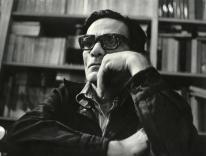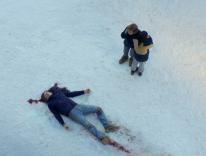Just my luck. I’m trying to come to grips with the most unsettling American film produced in several years, while circumstances dictate a deadline that nearly keeps me from thinking about the movie-much less writing about it. So please regard all that follows, not as a formal critique, but as “Notes toward the Definition of A History of Violence,” a film written by Josh Olson and directed by David Cronenberg.
Story: A prologue shows two sociopathic drifters committing a brutal motel robbery-massacre, the horror of which is excruciatingly amplified by the listlessness of its presentation. Then we are rerouted into the middle-class life of Tom and Edie Stall (Viggo Mortensen and Maria Bello) in a small town in Indiana. Without a trace of condescension or smiley-twinkly italicizing, we are shown how happy these two are, how snugly they fit into small-town life, how modestly profitable their diner is (Edie is also an attorney, but her practice has little connection to the story), the pride the couple takes in their two children, and the playful sensuality they still enjoy in the bedroom. All this might reek of the plastic normality of TV sitcoms, but the freshness and economy of the acting and direction keep it palatable. Palatable but doomed, since we know that the criminals must be coming to town and the Stalls are bound to be their prey. Sure enough, the murderers enter the eatery near closing time, lock the door, and attempt to rape a waitress while threatening the remaining customers and staff with death in such a way that we know the threat is really a promise. Who can save these innocents?
Tom saves them. He kills the attackers in a display of hair-trigger reflexes and martial skills worthy of James Bond. Of course Tom is acclaimed as a hero, but the unavoidable question arises: Why is Tom so good at killing people? The answer to that question precipitates the rest of the movie. There are many surprises to come and none of them are happy.
Theme: With reporters buzzing about Tom, and his teenage son trying to emulate dad’s prowess by pulping the school bully, I thought the main theme was to be the glorification of violence in our culture. But once a sinister individual named Fogarty (Ed Harris) and his thugs come to town and claim Tom as part of their world, even though he believably swears he’s never laid eyes on them, another theme takes over. Is a person allowed forgiveness for an immoral past after he demonstrates a genuinely reformed character and a willingness to live in society peacefully and even benevolently, but does not make legal reparation for specific crimes? Robert Duvall’s The Apostle explored the same moral terrain. Duvall’s murderer-hero flees the law because he wants to continue his evangelical mission. He does much good but once the police apprehend him, we never get to see the consequences the revelation of his criminality has for the people he befriended in his second life. A History of Violence digs deeper by showing that reformation itself can bring misery, when the sinful past hasn’t been laid to rest.
Characterization: Nothing profound here, yet all the characters except one are adequately sketched by screenwriter Josh Olson with economical strokes of incident and dialogue. Some (such as the school bully) are mere clichés fulfilling plot function, but others, like the town sheriff (well-played by Peter MacNeill), are given a burnish of shrewdness and bewilderment that keeps them human. All the criminals, with their need to turn their victims into caricatures before they kill them, are sickeningly believable. And the psychological journey of Edie Stall, first into fear and then into bitterness, is especially well written.
But the protagonist, Tom Stall, never quite emerges from his cloud of ambiguity, even after we learn of his past. For his plight to truly move us, we would have to be privy to how he experienced a profound conversion years before the events in the film. Since this conversion is only hinted at, Tom comes to resemble the Matt Damon character in The Bourne Identity, more compelling in the action sequences than in the soul-searching ones. That’s part of what is unsettling about History. Rather than being forthright psychological drama or knuckle-biting melodrama, it’s a somewhat deformed offspring of the two genres. (If you want a more satisfying blending of psychology and melodrama, see One False Move, starring Bill Paxton.)
Actors: That said, Viggo Mortensen is superb as Tom, as he should be since this psychological territory-normalcy spoiled by some internal twist-is his terrain (see his brilliant turn in The Indian Runner). Much of History’s substance resides in close-ups of Mortensen’s face, and the final one, in which the actor’s eyes plead, “Let me back in!” without a word being uttered, sums up the desperation and poignancy of the entire movie.
Maria Bello may be too movie-star lustrous for Edie but, especially in the later scenes, she communicates frustrated love and outraged trust magnificently. The supporting cast is uniformly good with an unrecognizable William Hurt combining clownishness and kingpin menace to perfection.
Direction: David Cronenberg must have had his own conversion experience before tackling this project. His fascination with body parts and weird sex made some of his previous movies repulsive to the point of risibility, though others (especially the 1986 The Fly) benefited from his obsession. But History taps into a surprising vein of compassion. Cronenberg’s flair for black comedy persists but it never turns the characters into cartoons. He knows when to get close to his characters and when to pull away. Consider the two scenes of lovemaking. In the first, which happens before the restaurant stick-up, the camera is tight on the faces of Tom and Edie as they mutually enjoy their tender intimacy. In the second, where sexual heat has been perversely provoked by desperation and anger, he gives us a flurry of scissoring legs, clutching hands, bare buttocks, vindictive faces, and breaks up this flurry with long shots of bodies writhing so furiously that each lover seems intent on doing the other an injury. Speaking of which...
Violence: Walking out of the theater, I felt I had just seen one of the most violent films ever made. Then I realized that there had been exactly three scenes of mortal violence (the prologue’s massacre is kept off camera and I’m not counting the high-school fisticuffs) and each had lasted less than a minute. I looked up History’s running time: ninety-eight minutes. So, three minutes of violence and ninety-five of emotion and dialogue and everything else. Not so bad...but the violent acts reverberate throughout the movie. They are History’s linchpins and watersheds.
Cronenberg trains his camera away from the suffering of innocents because he knows we derive no vicarious pleasure from that, but when gangsters and thugs are blown away and we are about to cheer the victory of good over evil, the camera closes in on blood-splattered faces and cracked craniums so that we catch our breath and the movie-induced cheers are caught in our throats. A History of Violence is often quite melodramatic, but it is also a reproach to our melodramatic cravings.
Please email comments to [email protected] and join the conversation on our Facebook page.
Share
Previous Story
This Writer's Life
Next Story
Opus Dei


